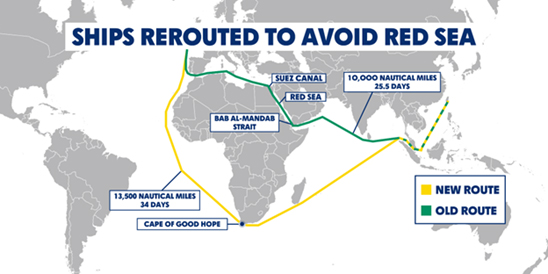How the Red Sea Crisis is Impacting Global Logistics

Corbus logistics and supply chain expert outlines strategies to mitigate risks.
Recent attacks on commercial shipping lines in the Red Sea due to geopolitical instability have disrupted international shipping operations—and have had a major impact on shipping costs, delivery times and customer satisfaction.
This level of impact signals a supply chain crisis.
Linking the Indian Ocean with the Mediterranean Sea via the Suez Canal, the Red Sea is one of the main trade routes across Asia, the Middle East and Europe. It is the fastest route between Europe and Asia, with nearly 20-30% of global shipping lines moving along this course.

While the alternative route is safer, it is longer and costlier. Increased fuel bills, longer lead times and higher insurance premiums will translate to higher prices for various goods and severe inflation.
For shipping industry and logistics professionals, the Red Sea crisis requires a deep understanding of the issue, its implications and the importance of a well-defined plan to maintain the flow of goods and services.
The evolving challenges of Red Sea shipping disruptions
Disruptions in the Red Sea shipping route pose a number of significant logistics challenges. It is crtical for industry professionals to understand and balance a broad range of implications.
- Delivery delays: Rerouting vessels from the Red Sea around the Cape of Good Hope has added two weeks to shipping schedules.
- Longer transit time: Transit time from major Chinese ports to major European ports has increased from 25-30 days to 40-60 days.
- Increased fuel costs: Increased transit time has greatly impacted fuel costs.
- Significant rates revision: The cost of shipping a container from China to Europe has surged with the addition of surcharges.
- Insurance increase: The crisis has driven up insurance premiums by 20%.
- Revenue loss: Many organizations posted 4th quarter operating losses due to lower transport volumes.
- Customer dissatisfaction: Longer lead times and increased costs have frustrated customers.
- Airfreight options: Air freight rates have jumped week over week.
- Inflation: The supply chain crisis creates a domino effect that will drive up the cost of goods.
Creating a risk management plan
In the face of the Red Sea crisis, effective logistics supply chain management will require identifying and mitigating risks, leaning on the essential components of diversification and contingency planning.
Our latest white paper, Red Sea Crisis and its Impact on Global Logistics Supply Chain Management, offers seven best practices to help logistics professionals safeguard against potential crises, as well as enhance the resilience and reliability of your global supply chain network:
- Establish effective coordination.
- Implement advance planning and discussion.
- Share production plans.
- Ensure timely booking requests.
- Require container availability confirmation.
- Coordinate efficient shipment movement.
- Engage outside experts.
The potential for future crises impacting global shipping underscores the importance of establishing a comprehensive plan that ensures the safety and security of shipments.
As you regularly evaluate and enhance your strategies for supply chain resilience and responsiveness, it’s essential to consider new trends and technologies that may impact your plan, such as automation and digitalization, sustainability, supply chain diversification and cybersecurity.
A collaborative approach
Rerouting vessels, implementing heightened security protocols and suspending operations in affected regions are key strategic measures — but a proactive, collaborative approach to planning and coordination among stakeholders is essential to minimizing disruptions to logistics supply chain management.
We understand that logistics is a crucial function for the success of businesses that rely on global waterways to move products. Our supply chain experts have extensive experience in logistics and are here to provide customers with the best possible support.
We work with shippers, logistics buyers, freight forwarders and shipping lines to swiftly adapt to emerging challenges, mitigate risks and ensure the continued flow of goods and services, even in the face of adverse circumstances.
Given the current geopolitical climate in the Red Sea area, we’re staying on top of the evolving situation and supporting our clients in navigating its challenges and implementing strategies to mitigate risk in the event of potential future crises.
To learn more about the Red Sea disruption and how to navigate its challenges, download our white paper, Red Sea Crisis and its Impact on Global Logistics Supply Chain Management.